Analyzing Capital Structure's Impact on Airline Financial Performance
VerifiedAdded on 2020/04/07
|57
|14387
|66
Report
AI Summary
This report investigates the impact of capital structure on the financial performance of airlines. It begins with an introduction outlining the aims and objectives of the research, which are to understand the relationship between capital structure and financial performance, and to identify key financial variables. The literature review explores agency theory, leverage, and dividend payout ratios, providing a theoretical foundation for the study. The methodology chapter details the research approach, design, and data analysis plan, including descriptive statistics, correlation analysis, and hypothesis testing. The data analysis and discussion chapter presents the findings, including the results of hypothesis testing related to trade-off, pecking order, and agency cost theories. The conclusion summarizes the key findings, limitations, and potential areas for future research. The report aims to provide insights into how airlines manage their capital structure and its effects on their financial outcomes, with a focus on the airline industry's unique characteristics and challenges.

Running head: THE IMPACT OF CAPITAL STRUCTURE ON THE FINANCIAL
PERFORMANCE OF AIRLINES
The impact of capital structure on the Financial Performance of Airlines
Name of the Student:
Name of the University:
Author’s Note:
PERFORMANCE OF AIRLINES
The impact of capital structure on the Financial Performance of Airlines
Name of the Student:
Name of the University:
Author’s Note:
Paraphrase This Document
Need a fresh take? Get an instant paraphrase of this document with our AI Paraphraser

1THE IMPACT OF CAPITAL STRUCTURE ON THE FINANCIAL PERFORMANCE OF
AIRLINES
Abstract
This paper has been constructed in order to have an idea about the capital structure that
is existent in the airline industry. The assessment of the capital structure is helpful for
understanding the financial performance of the airline industry. This research highlights the
process with the help of which the objectives of the research is constructed and the problem
that has to be assessed in this paper. This paper gathers data from the annual reports of the
airline companies and thereby understanding the financial performance of the companies. The
financial performance of the airline companies indicates the profitability of the firms and
thereby the processes they use in order to maintain competitive edge in the market. The
research indicates that financial performance has an impact on the capital structure of airline
industries and in that manner the companies constructs their plans and policies that aids in the
enhancement of the companies.
Table of Contents
AIRLINES
Abstract
This paper has been constructed in order to have an idea about the capital structure that
is existent in the airline industry. The assessment of the capital structure is helpful for
understanding the financial performance of the airline industry. This research highlights the
process with the help of which the objectives of the research is constructed and the problem
that has to be assessed in this paper. This paper gathers data from the annual reports of the
airline companies and thereby understanding the financial performance of the companies. The
financial performance of the airline companies indicates the profitability of the firms and
thereby the processes they use in order to maintain competitive edge in the market. The
research indicates that financial performance has an impact on the capital structure of airline
industries and in that manner the companies constructs their plans and policies that aids in the
enhancement of the companies.
Table of Contents

2THE IMPACT OF CAPITAL STRUCTURE ON THE FINANCIAL PERFORMANCE OF
AIRLINES
Chapter 1: Introduction..................................................................................................5
1.1 Aims and Objectives of the Research...................................................................6
Chapter 2: Literature review...........................................................................................7
2.0 Introduction...............................................................................................................7
2.1 Literature of Agency Theory:..............................................................................10
2.2 Leverage Literature:............................................................................................13
2.3 Dividends pay-out ratio literature:......................................................................14
2.4 Summary.............................................................................................................16
Chapter 3: Research Methodology................................................................................18
Introduction...............................................................................................................18
Research Onion.........................................................................................................18
Incorporation of the Research Methods....................................................................20
Research Philosophy.................................................................................................20
Research Approach...................................................................................................21
Research Design........................................................................................................23
Data Collection process and sample.........................................................................24
Data Analysis Plan and Reliability...........................................................................25
Limitations of the data sample..................................................................................25
Ethical Consideration................................................................................................26
Chapter 4: Data Analysis and Discussion.....................................................................27
AIRLINES
Chapter 1: Introduction..................................................................................................5
1.1 Aims and Objectives of the Research...................................................................6
Chapter 2: Literature review...........................................................................................7
2.0 Introduction...............................................................................................................7
2.1 Literature of Agency Theory:..............................................................................10
2.2 Leverage Literature:............................................................................................13
2.3 Dividends pay-out ratio literature:......................................................................14
2.4 Summary.............................................................................................................16
Chapter 3: Research Methodology................................................................................18
Introduction...............................................................................................................18
Research Onion.........................................................................................................18
Incorporation of the Research Methods....................................................................20
Research Philosophy.................................................................................................20
Research Approach...................................................................................................21
Research Design........................................................................................................23
Data Collection process and sample.........................................................................24
Data Analysis Plan and Reliability...........................................................................25
Limitations of the data sample..................................................................................25
Ethical Consideration................................................................................................26
Chapter 4: Data Analysis and Discussion.....................................................................27
⊘ This is a preview!⊘
Do you want full access?
Subscribe today to unlock all pages.

Trusted by 1+ million students worldwide
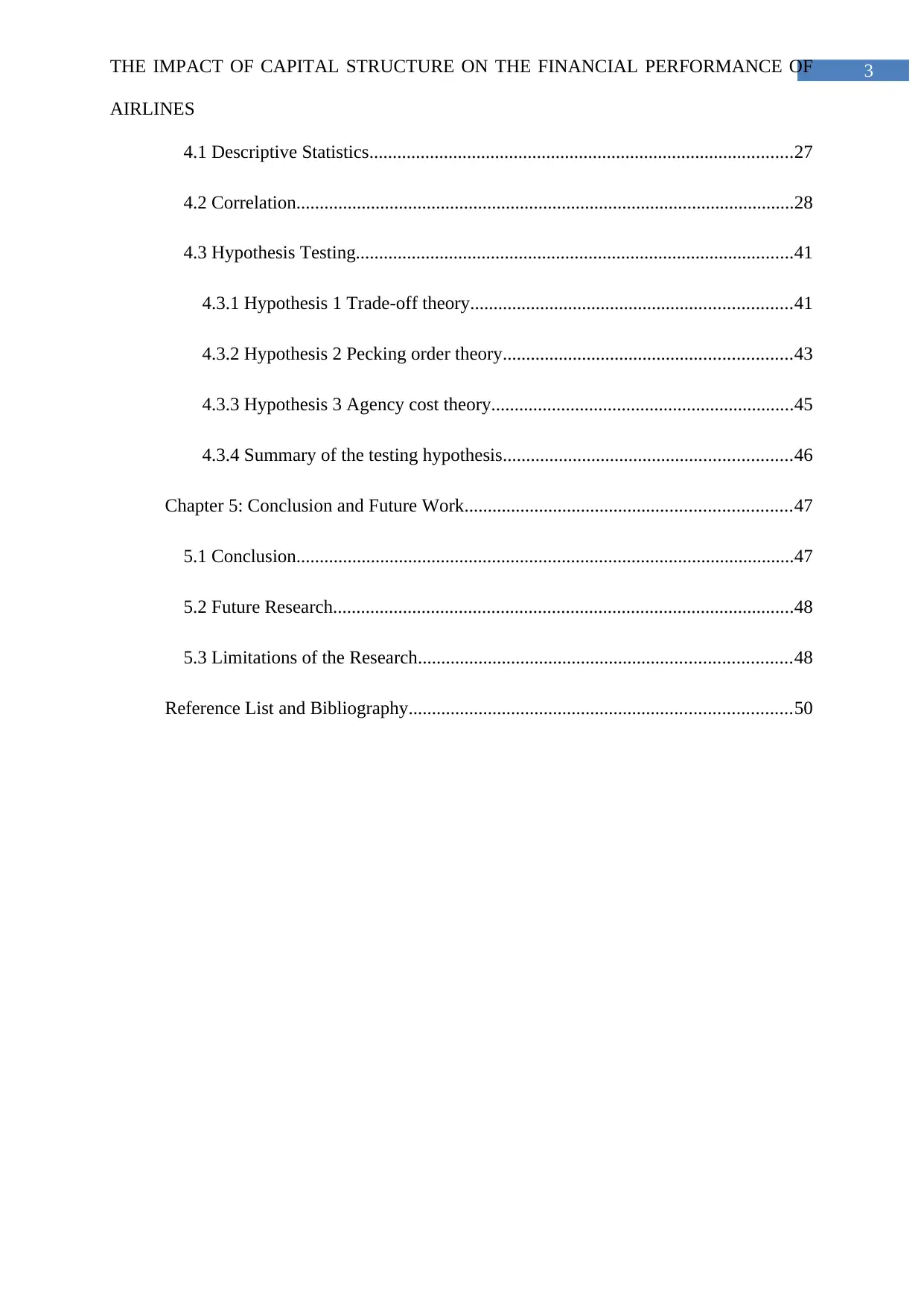
3THE IMPACT OF CAPITAL STRUCTURE ON THE FINANCIAL PERFORMANCE OF
AIRLINES
4.1 Descriptive Statistics...........................................................................................27
4.2 Correlation...........................................................................................................28
4.3 Hypothesis Testing..............................................................................................41
4.3.1 Hypothesis 1 Trade-off theory.....................................................................41
4.3.2 Hypothesis 2 Pecking order theory..............................................................43
4.3.3 Hypothesis 3 Agency cost theory.................................................................45
4.3.4 Summary of the testing hypothesis..............................................................46
Chapter 5: Conclusion and Future Work......................................................................47
5.1 Conclusion...........................................................................................................47
5.2 Future Research...................................................................................................48
5.3 Limitations of the Research................................................................................48
Reference List and Bibliography..................................................................................50
AIRLINES
4.1 Descriptive Statistics...........................................................................................27
4.2 Correlation...........................................................................................................28
4.3 Hypothesis Testing..............................................................................................41
4.3.1 Hypothesis 1 Trade-off theory.....................................................................41
4.3.2 Hypothesis 2 Pecking order theory..............................................................43
4.3.3 Hypothesis 3 Agency cost theory.................................................................45
4.3.4 Summary of the testing hypothesis..............................................................46
Chapter 5: Conclusion and Future Work......................................................................47
5.1 Conclusion...........................................................................................................47
5.2 Future Research...................................................................................................48
5.3 Limitations of the Research................................................................................48
Reference List and Bibliography..................................................................................50
Paraphrase This Document
Need a fresh take? Get an instant paraphrase of this document with our AI Paraphraser
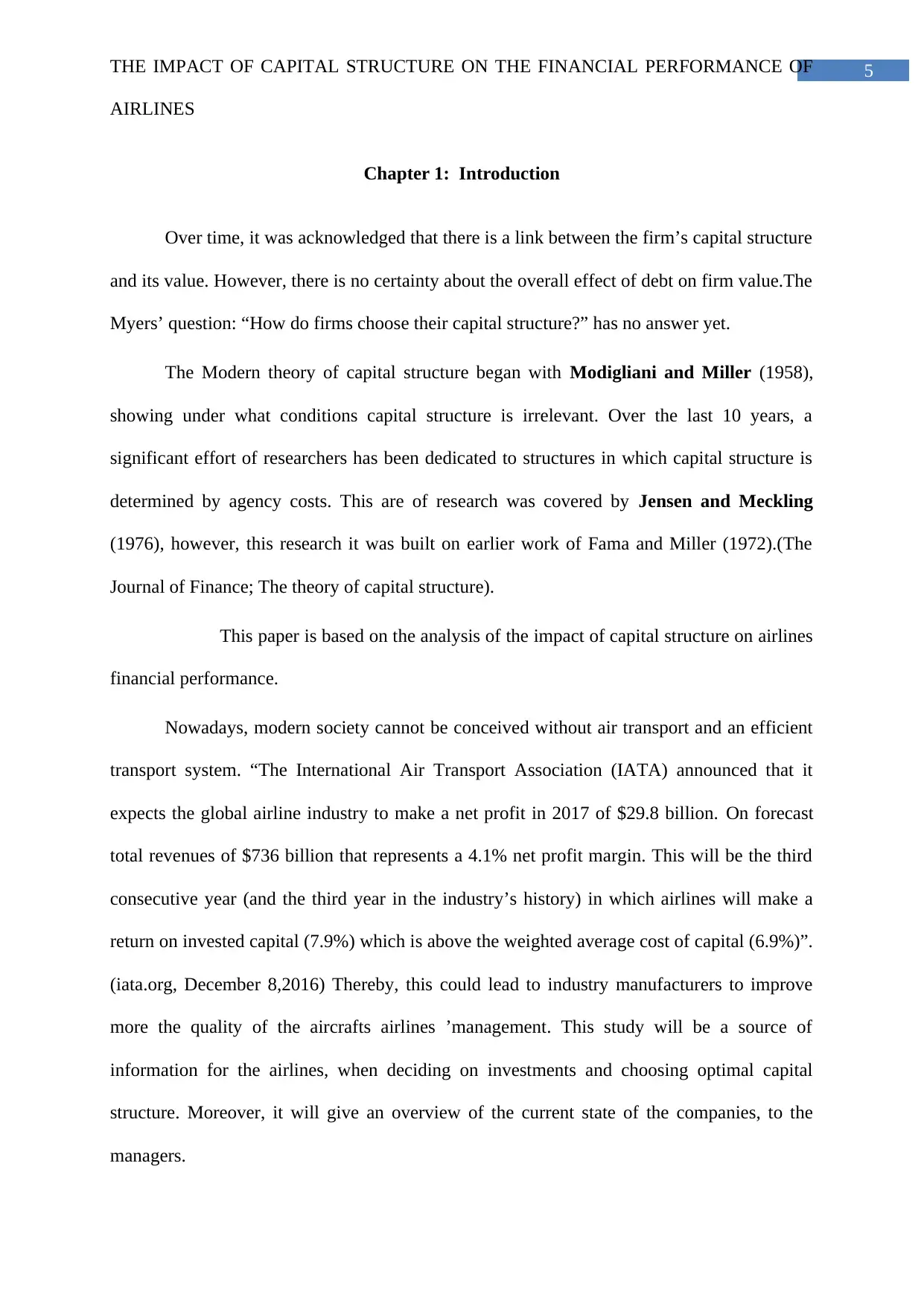
5THE IMPACT OF CAPITAL STRUCTURE ON THE FINANCIAL PERFORMANCE OF
AIRLINES
Chapter 1: Introduction
Over time, it was acknowledged that there is a link between the firm’s capital structure
and its value. However, there is no certainty about the overall effect of debt on firm value.The
Myers’ question: “How do firms choose their capital structure?” has no answer yet.
The Modern theory of capital structure began with Modigliani and Miller (1958),
showing under what conditions capital structure is irrelevant. Over the last 10 years, a
significant effort of researchers has been dedicated to structures in which capital structure is
determined by agency costs. This are of research was covered by Jensen and Meckling
(1976), however, this research it was built on earlier work of Fama and Miller (1972).(The
Journal of Finance; The theory of capital structure).
This paper is based on the analysis of the impact of capital structure on airlines
financial performance.
Nowadays, modern society cannot be conceived without air transport and an efficient
transport system. “The International Air Transport Association (IATA) announced that it
expects the global airline industry to make a net profit in 2017 of $29.8 billion. On forecast
total revenues of $736 billion that represents a 4.1% net profit margin. This will be the third
consecutive year (and the third year in the industry’s history) in which airlines will make a
return on invested capital (7.9%) which is above the weighted average cost of capital (6.9%)”.
(iata.org, December 8,2016) Thereby, this could lead to industry manufacturers to improve
more the quality of the aircrafts airlines ’management. This study will be a source of
information for the airlines, when deciding on investments and choosing optimal capital
structure. Moreover, it will give an overview of the current state of the companies, to the
managers.
AIRLINES
Chapter 1: Introduction
Over time, it was acknowledged that there is a link between the firm’s capital structure
and its value. However, there is no certainty about the overall effect of debt on firm value.The
Myers’ question: “How do firms choose their capital structure?” has no answer yet.
The Modern theory of capital structure began with Modigliani and Miller (1958),
showing under what conditions capital structure is irrelevant. Over the last 10 years, a
significant effort of researchers has been dedicated to structures in which capital structure is
determined by agency costs. This are of research was covered by Jensen and Meckling
(1976), however, this research it was built on earlier work of Fama and Miller (1972).(The
Journal of Finance; The theory of capital structure).
This paper is based on the analysis of the impact of capital structure on airlines
financial performance.
Nowadays, modern society cannot be conceived without air transport and an efficient
transport system. “The International Air Transport Association (IATA) announced that it
expects the global airline industry to make a net profit in 2017 of $29.8 billion. On forecast
total revenues of $736 billion that represents a 4.1% net profit margin. This will be the third
consecutive year (and the third year in the industry’s history) in which airlines will make a
return on invested capital (7.9%) which is above the weighted average cost of capital (6.9%)”.
(iata.org, December 8,2016) Thereby, this could lead to industry manufacturers to improve
more the quality of the aircrafts airlines ’management. This study will be a source of
information for the airlines, when deciding on investments and choosing optimal capital
structure. Moreover, it will give an overview of the current state of the companies, to the
managers.
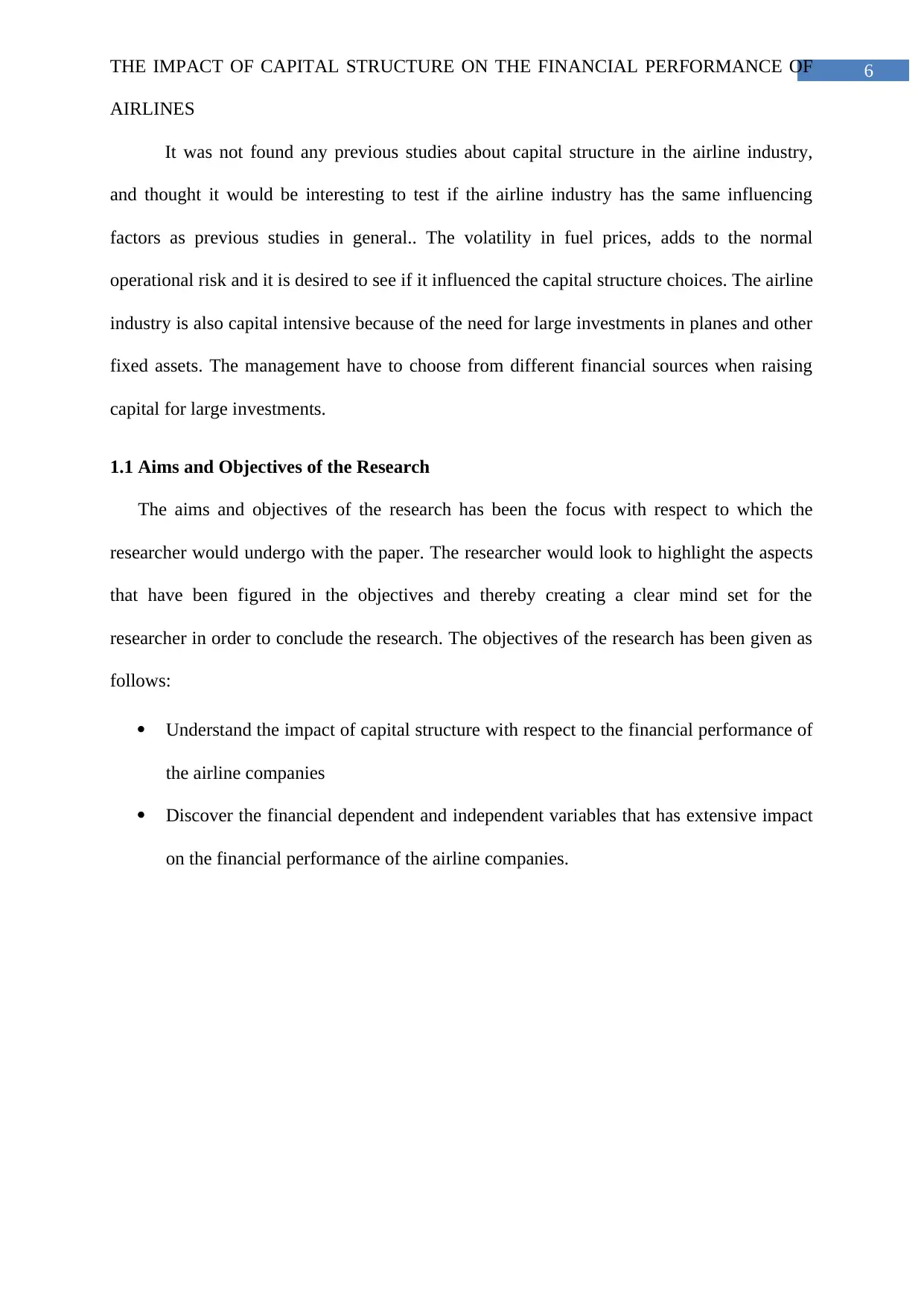
6THE IMPACT OF CAPITAL STRUCTURE ON THE FINANCIAL PERFORMANCE OF
AIRLINES
It was not found any previous studies about capital structure in the airline industry,
and thought it would be interesting to test if the airline industry has the same influencing
factors as previous studies in general.. The volatility in fuel prices, adds to the normal
operational risk and it is desired to see if it influenced the capital structure choices. The airline
industry is also capital intensive because of the need for large investments in planes and other
fixed assets. The management have to choose from different financial sources when raising
capital for large investments.
1.1 Aims and Objectives of the Research
The aims and objectives of the research has been the focus with respect to which the
researcher would undergo with the paper. The researcher would look to highlight the aspects
that have been figured in the objectives and thereby creating a clear mind set for the
researcher in order to conclude the research. The objectives of the research has been given as
follows:
Understand the impact of capital structure with respect to the financial performance of
the airline companies
Discover the financial dependent and independent variables that has extensive impact
on the financial performance of the airline companies.
AIRLINES
It was not found any previous studies about capital structure in the airline industry,
and thought it would be interesting to test if the airline industry has the same influencing
factors as previous studies in general.. The volatility in fuel prices, adds to the normal
operational risk and it is desired to see if it influenced the capital structure choices. The airline
industry is also capital intensive because of the need for large investments in planes and other
fixed assets. The management have to choose from different financial sources when raising
capital for large investments.
1.1 Aims and Objectives of the Research
The aims and objectives of the research has been the focus with respect to which the
researcher would undergo with the paper. The researcher would look to highlight the aspects
that have been figured in the objectives and thereby creating a clear mind set for the
researcher in order to conclude the research. The objectives of the research has been given as
follows:
Understand the impact of capital structure with respect to the financial performance of
the airline companies
Discover the financial dependent and independent variables that has extensive impact
on the financial performance of the airline companies.
⊘ This is a preview!⊘
Do you want full access?
Subscribe today to unlock all pages.

Trusted by 1+ million students worldwide
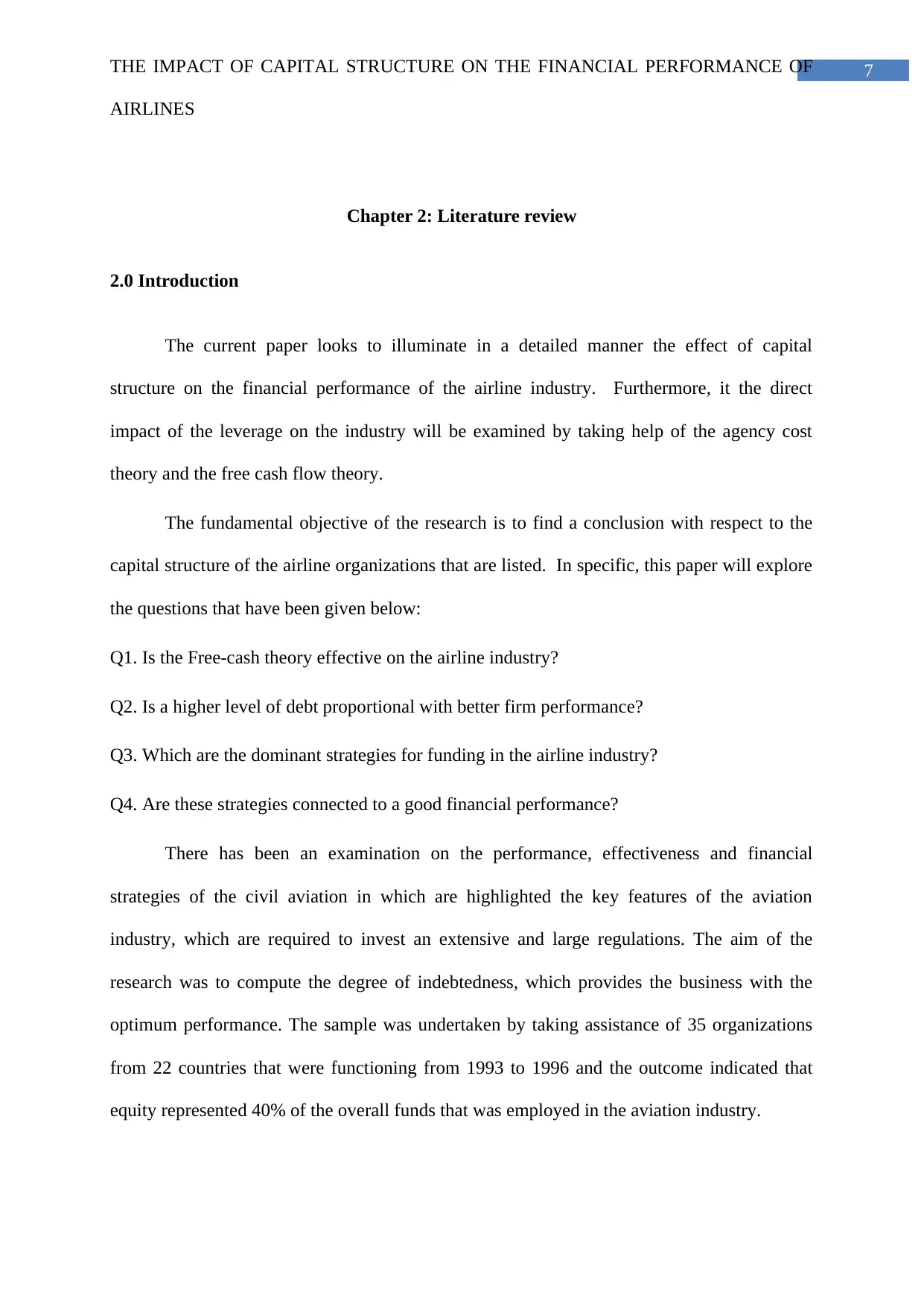
7THE IMPACT OF CAPITAL STRUCTURE ON THE FINANCIAL PERFORMANCE OF
AIRLINES
Chapter 2: Literature review
2.0 Introduction
The current paper looks to illuminate in a detailed manner the effect of capital
structure on the financial performance of the airline industry. Furthermore, it the direct
impact of the leverage on the industry will be examined by taking help of the agency cost
theory and the free cash flow theory.
The fundamental objective of the research is to find a conclusion with respect to the
capital structure of the airline organizations that are listed. In specific, this paper will explore
the questions that have been given below:
Q1. Is the Free-cash theory effective on the airline industry?
Q2. Is a higher level of debt proportional with better firm performance?
Q3. Which are the dominant strategies for funding in the airline industry?
Q4. Are these strategies connected to a good financial performance?
There has been an examination on the performance, effectiveness and financial
strategies of the civil aviation in which are highlighted the key features of the aviation
industry, which are required to invest an extensive and large regulations. The aim of the
research was to compute the degree of indebtedness, which provides the business with the
optimum performance. The sample was undertaken by taking assistance of 35 organizations
from 22 countries that were functioning from 1993 to 1996 and the outcome indicated that
equity represented 40% of the overall funds that was employed in the aviation industry.
AIRLINES
Chapter 2: Literature review
2.0 Introduction
The current paper looks to illuminate in a detailed manner the effect of capital
structure on the financial performance of the airline industry. Furthermore, it the direct
impact of the leverage on the industry will be examined by taking help of the agency cost
theory and the free cash flow theory.
The fundamental objective of the research is to find a conclusion with respect to the
capital structure of the airline organizations that are listed. In specific, this paper will explore
the questions that have been given below:
Q1. Is the Free-cash theory effective on the airline industry?
Q2. Is a higher level of debt proportional with better firm performance?
Q3. Which are the dominant strategies for funding in the airline industry?
Q4. Are these strategies connected to a good financial performance?
There has been an examination on the performance, effectiveness and financial
strategies of the civil aviation in which are highlighted the key features of the aviation
industry, which are required to invest an extensive and large regulations. The aim of the
research was to compute the degree of indebtedness, which provides the business with the
optimum performance. The sample was undertaken by taking assistance of 35 organizations
from 22 countries that were functioning from 1993 to 1996 and the outcome indicated that
equity represented 40% of the overall funds that was employed in the aviation industry.
Paraphrase This Document
Need a fresh take? Get an instant paraphrase of this document with our AI Paraphraser
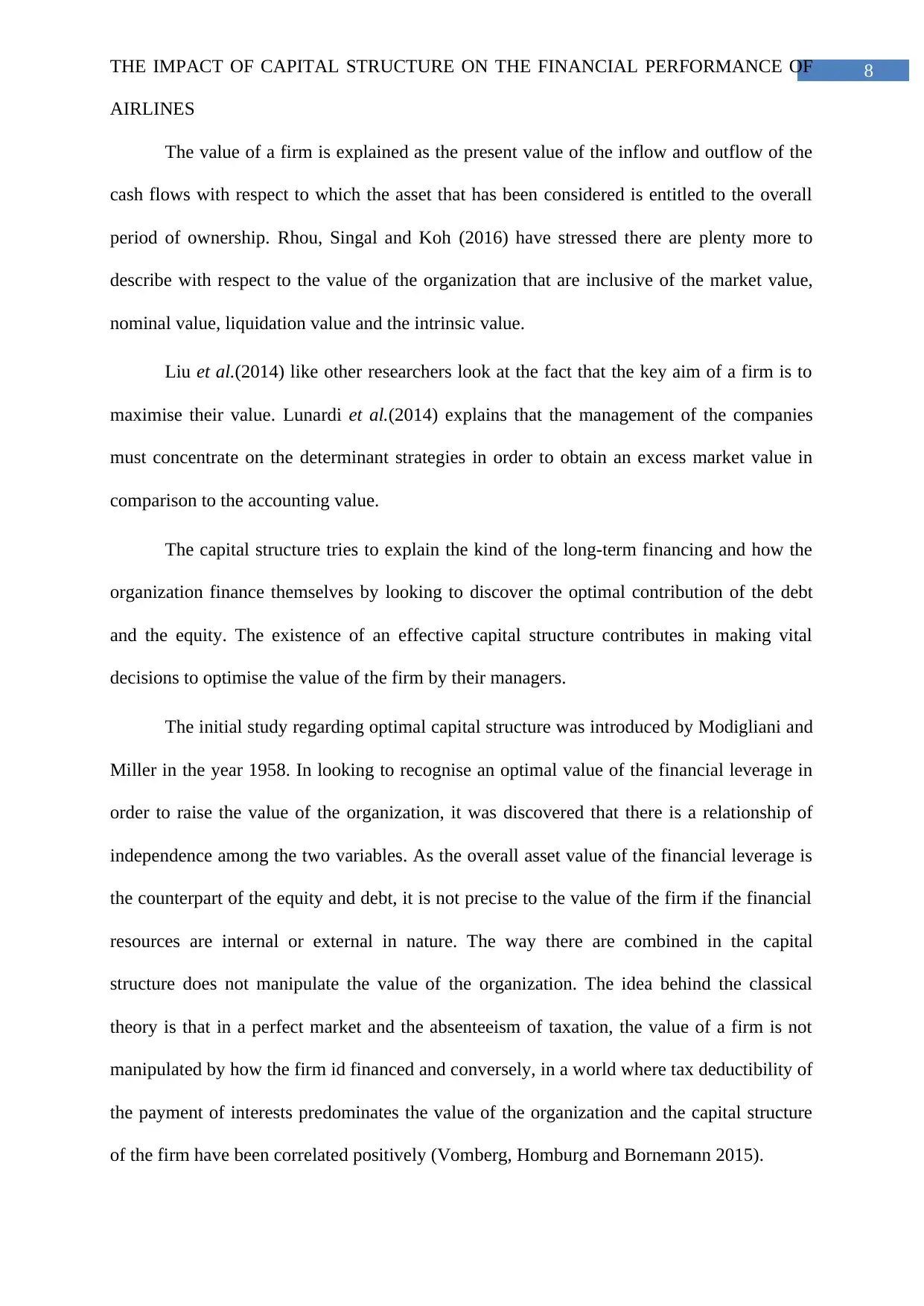
8THE IMPACT OF CAPITAL STRUCTURE ON THE FINANCIAL PERFORMANCE OF
AIRLINES
The value of a firm is explained as the present value of the inflow and outflow of the
cash flows with respect to which the asset that has been considered is entitled to the overall
period of ownership. Rhou, Singal and Koh (2016) have stressed there are plenty more to
describe with respect to the value of the organization that are inclusive of the market value,
nominal value, liquidation value and the intrinsic value.
Liu et al.(2014) like other researchers look at the fact that the key aim of a firm is to
maximise their value. Lunardi et al.(2014) explains that the management of the companies
must concentrate on the determinant strategies in order to obtain an excess market value in
comparison to the accounting value.
The capital structure tries to explain the kind of the long-term financing and how the
organization finance themselves by looking to discover the optimal contribution of the debt
and the equity. The existence of an effective capital structure contributes in making vital
decisions to optimise the value of the firm by their managers.
The initial study regarding optimal capital structure was introduced by Modigliani and
Miller in the year 1958. In looking to recognise an optimal value of the financial leverage in
order to raise the value of the organization, it was discovered that there is a relationship of
independence among the two variables. As the overall asset value of the financial leverage is
the counterpart of the equity and debt, it is not precise to the value of the firm if the financial
resources are internal or external in nature. The way there are combined in the capital
structure does not manipulate the value of the organization. The idea behind the classical
theory is that in a perfect market and the absenteeism of taxation, the value of a firm is not
manipulated by how the firm id financed and conversely, in a world where tax deductibility of
the payment of interests predominates the value of the organization and the capital structure
of the firm have been correlated positively (Vomberg, Homburg and Bornemann 2015).
AIRLINES
The value of a firm is explained as the present value of the inflow and outflow of the
cash flows with respect to which the asset that has been considered is entitled to the overall
period of ownership. Rhou, Singal and Koh (2016) have stressed there are plenty more to
describe with respect to the value of the organization that are inclusive of the market value,
nominal value, liquidation value and the intrinsic value.
Liu et al.(2014) like other researchers look at the fact that the key aim of a firm is to
maximise their value. Lunardi et al.(2014) explains that the management of the companies
must concentrate on the determinant strategies in order to obtain an excess market value in
comparison to the accounting value.
The capital structure tries to explain the kind of the long-term financing and how the
organization finance themselves by looking to discover the optimal contribution of the debt
and the equity. The existence of an effective capital structure contributes in making vital
decisions to optimise the value of the firm by their managers.
The initial study regarding optimal capital structure was introduced by Modigliani and
Miller in the year 1958. In looking to recognise an optimal value of the financial leverage in
order to raise the value of the organization, it was discovered that there is a relationship of
independence among the two variables. As the overall asset value of the financial leverage is
the counterpart of the equity and debt, it is not precise to the value of the firm if the financial
resources are internal or external in nature. The way there are combined in the capital
structure does not manipulate the value of the organization. The idea behind the classical
theory is that in a perfect market and the absenteeism of taxation, the value of a firm is not
manipulated by how the firm id financed and conversely, in a world where tax deductibility of
the payment of interests predominates the value of the organization and the capital structure
of the firm have been correlated positively (Vomberg, Homburg and Bornemann 2015).
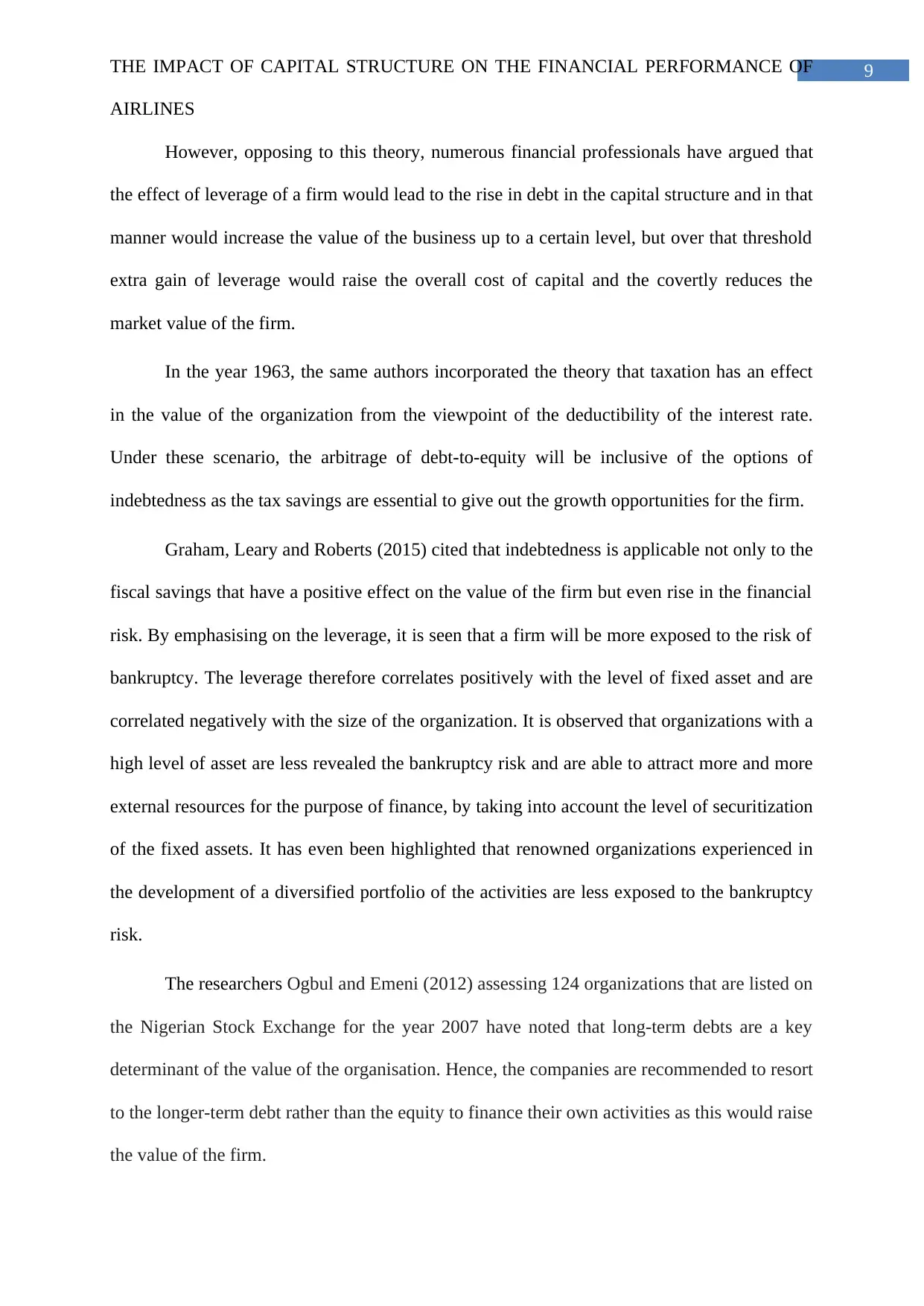
9THE IMPACT OF CAPITAL STRUCTURE ON THE FINANCIAL PERFORMANCE OF
AIRLINES
However, opposing to this theory, numerous financial professionals have argued that
the effect of leverage of a firm would lead to the rise in debt in the capital structure and in that
manner would increase the value of the business up to a certain level, but over that threshold
extra gain of leverage would raise the overall cost of capital and the covertly reduces the
market value of the firm.
In the year 1963, the same authors incorporated the theory that taxation has an effect
in the value of the organization from the viewpoint of the deductibility of the interest rate.
Under these scenario, the arbitrage of debt-to-equity will be inclusive of the options of
indebtedness as the tax savings are essential to give out the growth opportunities for the firm.
Graham, Leary and Roberts (2015) cited that indebtedness is applicable not only to the
fiscal savings that have a positive effect on the value of the firm but even rise in the financial
risk. By emphasising on the leverage, it is seen that a firm will be more exposed to the risk of
bankruptcy. The leverage therefore correlates positively with the level of fixed asset and are
correlated negatively with the size of the organization. It is observed that organizations with a
high level of asset are less revealed the bankruptcy risk and are able to attract more and more
external resources for the purpose of finance, by taking into account the level of securitization
of the fixed assets. It has even been highlighted that renowned organizations experienced in
the development of a diversified portfolio of the activities are less exposed to the bankruptcy
risk.
The researchers Ogbul and Emeni (2012) assessing 124 organizations that are listed on
the Nigerian Stock Exchange for the year 2007 have noted that long-term debts are a key
determinant of the value of the organisation. Hence, the companies are recommended to resort
to the longer-term debt rather than the equity to finance their own activities as this would raise
the value of the firm.
AIRLINES
However, opposing to this theory, numerous financial professionals have argued that
the effect of leverage of a firm would lead to the rise in debt in the capital structure and in that
manner would increase the value of the business up to a certain level, but over that threshold
extra gain of leverage would raise the overall cost of capital and the covertly reduces the
market value of the firm.
In the year 1963, the same authors incorporated the theory that taxation has an effect
in the value of the organization from the viewpoint of the deductibility of the interest rate.
Under these scenario, the arbitrage of debt-to-equity will be inclusive of the options of
indebtedness as the tax savings are essential to give out the growth opportunities for the firm.
Graham, Leary and Roberts (2015) cited that indebtedness is applicable not only to the
fiscal savings that have a positive effect on the value of the firm but even rise in the financial
risk. By emphasising on the leverage, it is seen that a firm will be more exposed to the risk of
bankruptcy. The leverage therefore correlates positively with the level of fixed asset and are
correlated negatively with the size of the organization. It is observed that organizations with a
high level of asset are less revealed the bankruptcy risk and are able to attract more and more
external resources for the purpose of finance, by taking into account the level of securitization
of the fixed assets. It has even been highlighted that renowned organizations experienced in
the development of a diversified portfolio of the activities are less exposed to the bankruptcy
risk.
The researchers Ogbul and Emeni (2012) assessing 124 organizations that are listed on
the Nigerian Stock Exchange for the year 2007 have noted that long-term debts are a key
determinant of the value of the organisation. Hence, the companies are recommended to resort
to the longer-term debt rather than the equity to finance their own activities as this would raise
the value of the firm.
⊘ This is a preview!⊘
Do you want full access?
Subscribe today to unlock all pages.

Trusted by 1+ million students worldwide
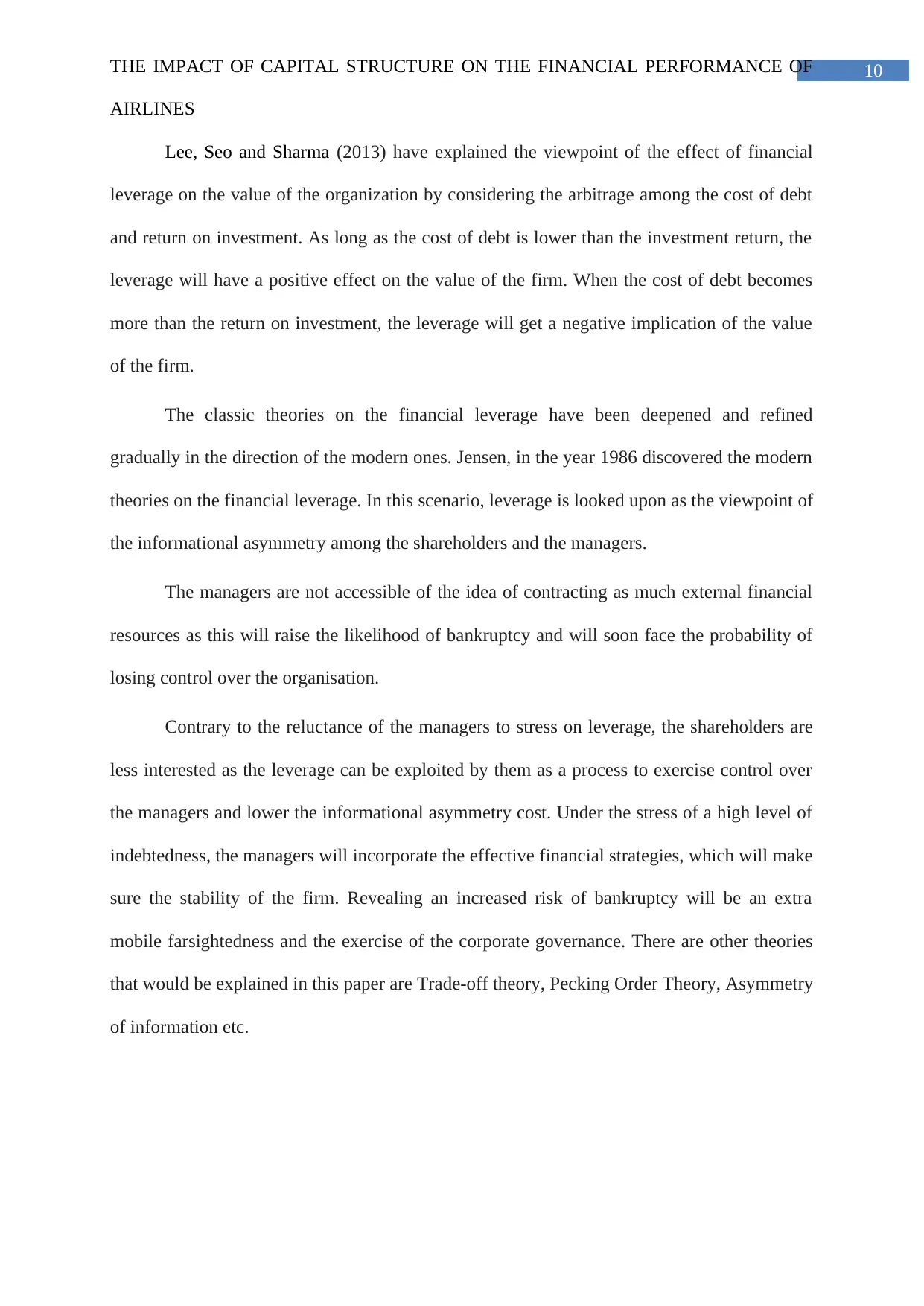
10THE IMPACT OF CAPITAL STRUCTURE ON THE FINANCIAL PERFORMANCE OF
AIRLINES
Lee, Seo and Sharma (2013) have explained the viewpoint of the effect of financial
leverage on the value of the organization by considering the arbitrage among the cost of debt
and return on investment. As long as the cost of debt is lower than the investment return, the
leverage will have a positive effect on the value of the firm. When the cost of debt becomes
more than the return on investment, the leverage will get a negative implication of the value
of the firm.
The classic theories on the financial leverage have been deepened and refined
gradually in the direction of the modern ones. Jensen, in the year 1986 discovered the modern
theories on the financial leverage. In this scenario, leverage is looked upon as the viewpoint of
the informational asymmetry among the shareholders and the managers.
The managers are not accessible of the idea of contracting as much external financial
resources as this will raise the likelihood of bankruptcy and will soon face the probability of
losing control over the organisation.
Contrary to the reluctance of the managers to stress on leverage, the shareholders are
less interested as the leverage can be exploited by them as a process to exercise control over
the managers and lower the informational asymmetry cost. Under the stress of a high level of
indebtedness, the managers will incorporate the effective financial strategies, which will make
sure the stability of the firm. Revealing an increased risk of bankruptcy will be an extra
mobile farsightedness and the exercise of the corporate governance. There are other theories
that would be explained in this paper are Trade-off theory, Pecking Order Theory, Asymmetry
of information etc.
AIRLINES
Lee, Seo and Sharma (2013) have explained the viewpoint of the effect of financial
leverage on the value of the organization by considering the arbitrage among the cost of debt
and return on investment. As long as the cost of debt is lower than the investment return, the
leverage will have a positive effect on the value of the firm. When the cost of debt becomes
more than the return on investment, the leverage will get a negative implication of the value
of the firm.
The classic theories on the financial leverage have been deepened and refined
gradually in the direction of the modern ones. Jensen, in the year 1986 discovered the modern
theories on the financial leverage. In this scenario, leverage is looked upon as the viewpoint of
the informational asymmetry among the shareholders and the managers.
The managers are not accessible of the idea of contracting as much external financial
resources as this will raise the likelihood of bankruptcy and will soon face the probability of
losing control over the organisation.
Contrary to the reluctance of the managers to stress on leverage, the shareholders are
less interested as the leverage can be exploited by them as a process to exercise control over
the managers and lower the informational asymmetry cost. Under the stress of a high level of
indebtedness, the managers will incorporate the effective financial strategies, which will make
sure the stability of the firm. Revealing an increased risk of bankruptcy will be an extra
mobile farsightedness and the exercise of the corporate governance. There are other theories
that would be explained in this paper are Trade-off theory, Pecking Order Theory, Asymmetry
of information etc.
Paraphrase This Document
Need a fresh take? Get an instant paraphrase of this document with our AI Paraphraser
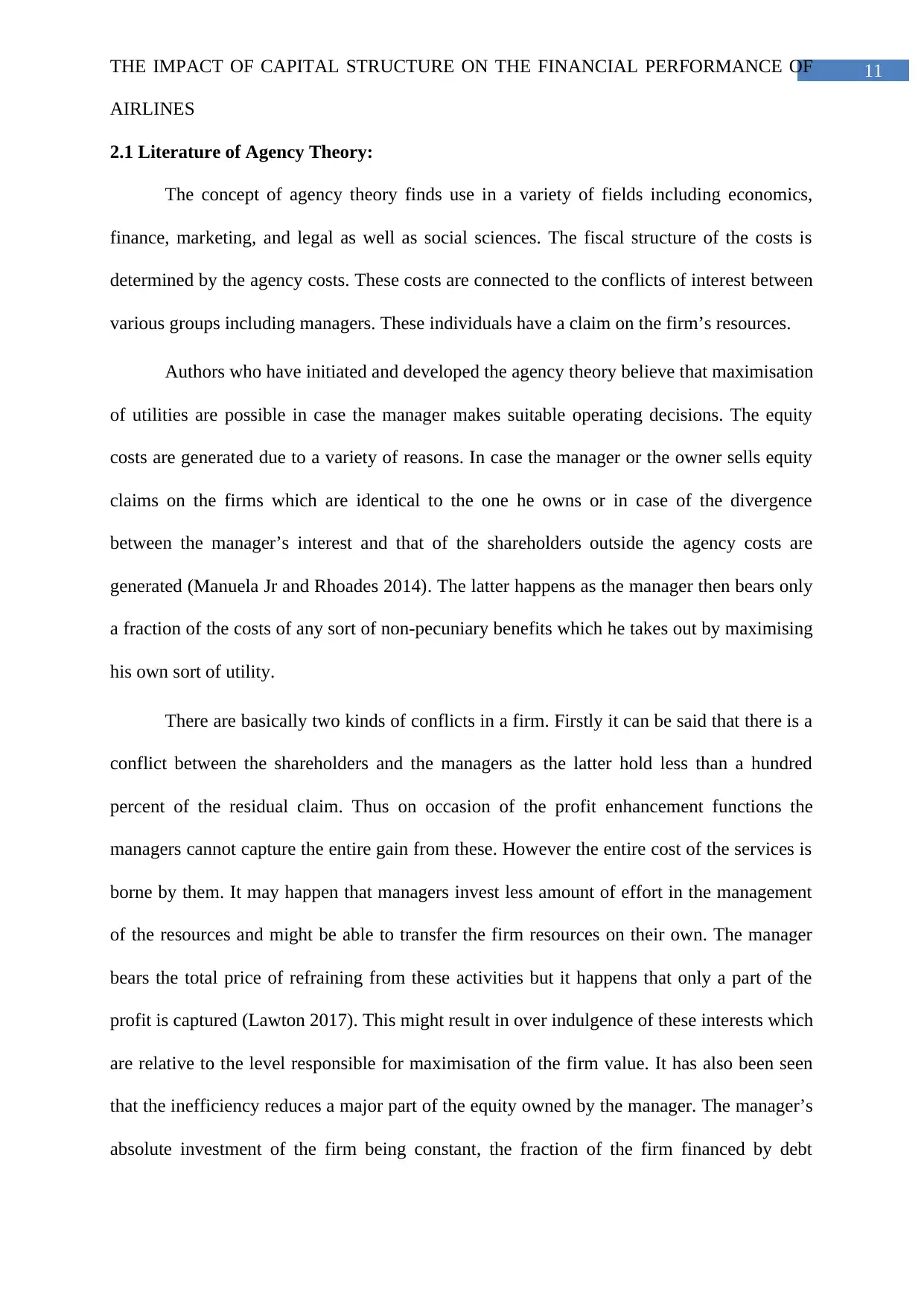
11THE IMPACT OF CAPITAL STRUCTURE ON THE FINANCIAL PERFORMANCE OF
AIRLINES
2.1 Literature of Agency Theory:
The concept of agency theory finds use in a variety of fields including economics,
finance, marketing, and legal as well as social sciences. The fiscal structure of the costs is
determined by the agency costs. These costs are connected to the conflicts of interest between
various groups including managers. These individuals have a claim on the firm’s resources.
Authors who have initiated and developed the agency theory believe that maximisation
of utilities are possible in case the manager makes suitable operating decisions. The equity
costs are generated due to a variety of reasons. In case the manager or the owner sells equity
claims on the firms which are identical to the one he owns or in case of the divergence
between the manager’s interest and that of the shareholders outside the agency costs are
generated (Manuela Jr and Rhoades 2014). The latter happens as the manager then bears only
a fraction of the costs of any sort of non-pecuniary benefits which he takes out by maximising
his own sort of utility.
There are basically two kinds of conflicts in a firm. Firstly it can be said that there is a
conflict between the shareholders and the managers as the latter hold less than a hundred
percent of the residual claim. Thus on occasion of the profit enhancement functions the
managers cannot capture the entire gain from these. However the entire cost of the services is
borne by them. It may happen that managers invest less amount of effort in the management
of the resources and might be able to transfer the firm resources on their own. The manager
bears the total price of refraining from these activities but it happens that only a part of the
profit is captured (Lawton 2017). This might result in over indulgence of these interests which
are relative to the level responsible for maximisation of the firm value. It has also been seen
that the inefficiency reduces a major part of the equity owned by the manager. The manager’s
absolute investment of the firm being constant, the fraction of the firm financed by debt
AIRLINES
2.1 Literature of Agency Theory:
The concept of agency theory finds use in a variety of fields including economics,
finance, marketing, and legal as well as social sciences. The fiscal structure of the costs is
determined by the agency costs. These costs are connected to the conflicts of interest between
various groups including managers. These individuals have a claim on the firm’s resources.
Authors who have initiated and developed the agency theory believe that maximisation
of utilities are possible in case the manager makes suitable operating decisions. The equity
costs are generated due to a variety of reasons. In case the manager or the owner sells equity
claims on the firms which are identical to the one he owns or in case of the divergence
between the manager’s interest and that of the shareholders outside the agency costs are
generated (Manuela Jr and Rhoades 2014). The latter happens as the manager then bears only
a fraction of the costs of any sort of non-pecuniary benefits which he takes out by maximising
his own sort of utility.
There are basically two kinds of conflicts in a firm. Firstly it can be said that there is a
conflict between the shareholders and the managers as the latter hold less than a hundred
percent of the residual claim. Thus on occasion of the profit enhancement functions the
managers cannot capture the entire gain from these. However the entire cost of the services is
borne by them. It may happen that managers invest less amount of effort in the management
of the resources and might be able to transfer the firm resources on their own. The manager
bears the total price of refraining from these activities but it happens that only a part of the
profit is captured (Lawton 2017). This might result in over indulgence of these interests which
are relative to the level responsible for maximisation of the firm value. It has also been seen
that the inefficiency reduces a major part of the equity owned by the manager. The manager’s
absolute investment of the firm being constant, the fraction of the firm financed by debt
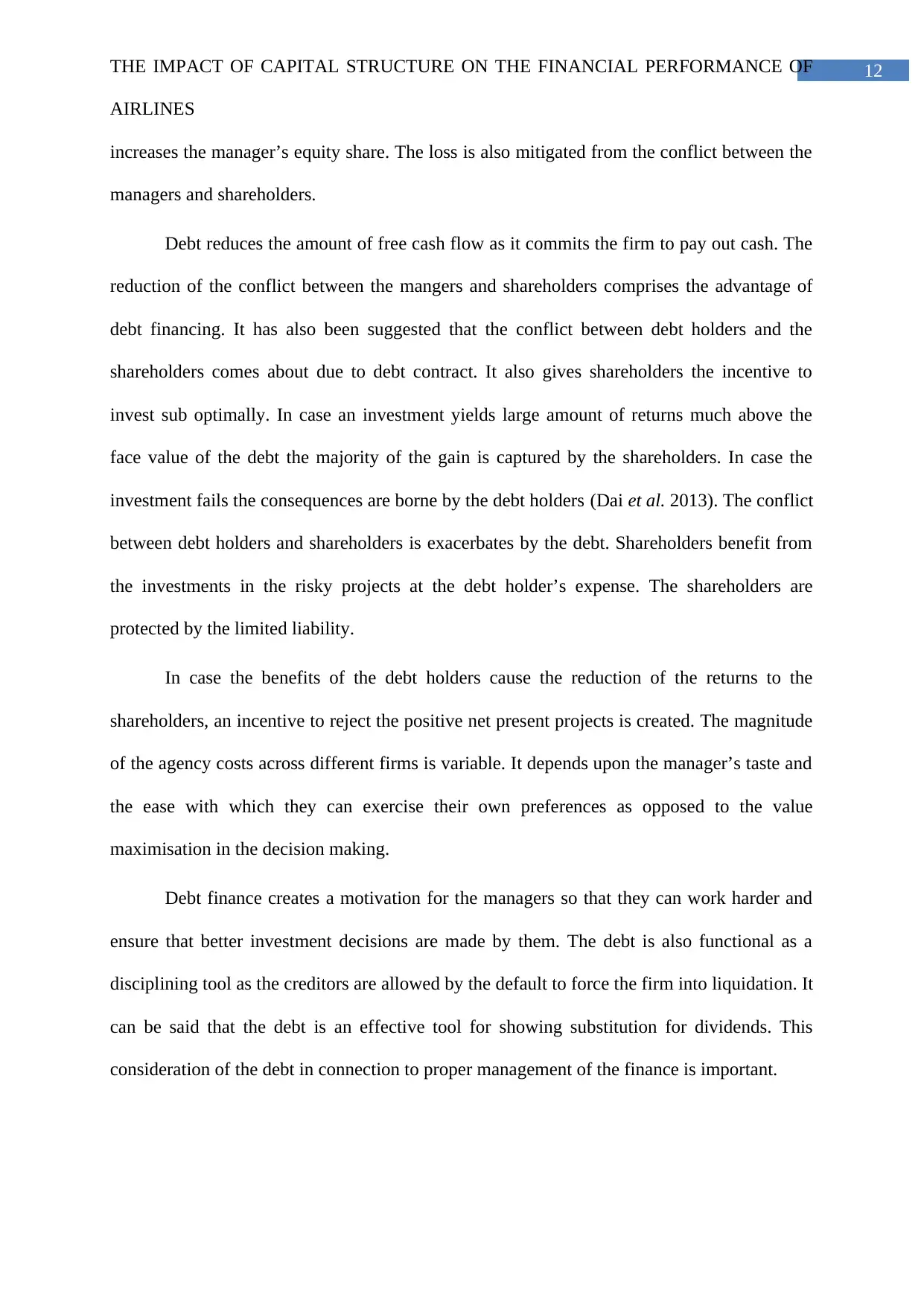
12THE IMPACT OF CAPITAL STRUCTURE ON THE FINANCIAL PERFORMANCE OF
AIRLINES
increases the manager’s equity share. The loss is also mitigated from the conflict between the
managers and shareholders.
Debt reduces the amount of free cash flow as it commits the firm to pay out cash. The
reduction of the conflict between the mangers and shareholders comprises the advantage of
debt financing. It has also been suggested that the conflict between debt holders and the
shareholders comes about due to debt contract. It also gives shareholders the incentive to
invest sub optimally. In case an investment yields large amount of returns much above the
face value of the debt the majority of the gain is captured by the shareholders. In case the
investment fails the consequences are borne by the debt holders (Dai et al. 2013). The conflict
between debt holders and shareholders is exacerbates by the debt. Shareholders benefit from
the investments in the risky projects at the debt holder’s expense. The shareholders are
protected by the limited liability.
In case the benefits of the debt holders cause the reduction of the returns to the
shareholders, an incentive to reject the positive net present projects is created. The magnitude
of the agency costs across different firms is variable. It depends upon the manager’s taste and
the ease with which they can exercise their own preferences as opposed to the value
maximisation in the decision making.
Debt finance creates a motivation for the managers so that they can work harder and
ensure that better investment decisions are made by them. The debt is also functional as a
disciplining tool as the creditors are allowed by the default to force the firm into liquidation. It
can be said that the debt is an effective tool for showing substitution for dividends. This
consideration of the debt in connection to proper management of the finance is important.
AIRLINES
increases the manager’s equity share. The loss is also mitigated from the conflict between the
managers and shareholders.
Debt reduces the amount of free cash flow as it commits the firm to pay out cash. The
reduction of the conflict between the mangers and shareholders comprises the advantage of
debt financing. It has also been suggested that the conflict between debt holders and the
shareholders comes about due to debt contract. It also gives shareholders the incentive to
invest sub optimally. In case an investment yields large amount of returns much above the
face value of the debt the majority of the gain is captured by the shareholders. In case the
investment fails the consequences are borne by the debt holders (Dai et al. 2013). The conflict
between debt holders and shareholders is exacerbates by the debt. Shareholders benefit from
the investments in the risky projects at the debt holder’s expense. The shareholders are
protected by the limited liability.
In case the benefits of the debt holders cause the reduction of the returns to the
shareholders, an incentive to reject the positive net present projects is created. The magnitude
of the agency costs across different firms is variable. It depends upon the manager’s taste and
the ease with which they can exercise their own preferences as opposed to the value
maximisation in the decision making.
Debt finance creates a motivation for the managers so that they can work harder and
ensure that better investment decisions are made by them. The debt is also functional as a
disciplining tool as the creditors are allowed by the default to force the firm into liquidation. It
can be said that the debt is an effective tool for showing substitution for dividends. This
consideration of the debt in connection to proper management of the finance is important.
⊘ This is a preview!⊘
Do you want full access?
Subscribe today to unlock all pages.

Trusted by 1+ million students worldwide
1 out of 57
Related Documents
Your All-in-One AI-Powered Toolkit for Academic Success.
+13062052269
info@desklib.com
Available 24*7 on WhatsApp / Email
![[object Object]](/_next/static/media/star-bottom.7253800d.svg)
Unlock your academic potential
Copyright © 2020–2025 A2Z Services. All Rights Reserved. Developed and managed by ZUCOL.





